- Clone
- RPA-T8 (See other available formats)
- Regulatory Status
- RUO
- Workshop
- IV T171
- Other Names
- T8, Leu2
- Isotype
- Mouse IgG1, κ
- Ave. Rating
- Submit a Review
- Product Citations
- publications
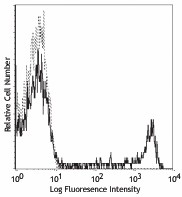
-

Human peripheral blood lymphocytes stained with RPA-T8 PE -

Human peripheral blood was stained with CD8a (clone RPA-T8) PE (solid line) or mouse IgG1, κ PE isotype control (dashed line).
Data was acquired on the Moxi Flow, exported, and processed using FlowJo software.
CD8a is a 32-34 kD type I glycoprotein. It forms a homodimer (CD8a/a) or heterodimer (CD8a/b) with CD8b. CD8, also known as T8 and Leu2, is a member of the immunoglobulin superfamily found on the majority of thymocytes, a subset of peripheral blood T cells, and NK cells (which express almost exclusively CD8a homodimers). CD8 acts as a co-receptor with MHC class I-restricted T cell receptors in antigen recognition and T cell activation, and has been shown to play a role in thymic differentiation. Two domains in CD8a are important for function: the extracellular IgSF domain binds the α3 domain of MHC class I and the cytoplasmic CXCP motif binds the tyrosine kinase p56 Lck.
Product DetailsProduct Details
- Verified Reactivity
- Human, Cynomolgus, Rhesus
- Reported Reactivity
- Chimpanzee, Baboon, Pigtailed Macaque, Sooty Mangabey
- Antibody Type
- Monoclonal
- Host Species
- Mouse
- Formulation
-
µg size: Phosphate-buffered solution, pH 7.2, containing 0.09% sodium azide.
test sizes: Phosphate-buffered solution, pH 7.2, containing 0.09% sodium azide and BSA (origin USA). - Preparation
- The antibody was purified by affinity chromatography, and conjugated with PE under optimal conditions.
- Concentration
- µg sizes: 0.2 mg/mLtest sizes: lot-specific (to obtain lot-specific concentration and expiration, please enter the lot number in our Certificate of Analysis online tool.)
- Storage & Handling
- The antibody solution should be stored undiluted between 2°C and 8°C, and protected from prolonged exposure to light. Do not freeze.
- Application
-
FC - Quality tested
- Recommended Usage
-
Each lot of this antibody is quality control tested by immunofluorescent staining with flow cytometric analysis. For flow cytometric staining using the µg size, the suggested use of this reagent is ≤0.5 µg per million cells in 100 µl volume. It is recommended that the reagent be titrated for optimal performance for each application. For flow cytometric staining using the test sizes, the suggested use of this reagent is 5 µl per million cells in 100 µl staining volume or 5 µl per 100 µl of whole blood.
- Excitation Laser
-
Blue Laser (488 nm)
Green Laser (532 nm)/Yellow-Green Laser (561 nm)
- Application Notes
-
The RPA-T8 antibody does not block the binding of HIT8a antibody to CD8a. Additional reported applications of this antibody (for the relevant formats) include: immunohistochemical staining of paraformaldehyde-fixed frozen sections3 and costimulation of T cell responses4. This clone was tested in-house and does not work on formalin fixed paraffin-embedded (FFPE) tissue. The Ultra-LEAF™ purified antibody (Endotoxin <0.1 EU/µg, Azide-Free, 0.2 µm filtered) is recommended for functional assays (Cat. Nos. 301073 & 301074).
-
Application References
(PubMed link indicates BioLegend citation) -
- Knapp W, et al. Eds. 1989. Leucocyte Typing IV. Oxford University Press. New York.
- Schlossman S, et al. Eds. 1995. Leucocyte Typing V. Oxford University Press. New York.
- Mack CL, et al. 2004. Pediatr. Res. 56:79. (IHC)
- Magidovich E, et al. 2007. P. Natl. Acad. Sci. USA 104:13022.
- Thakarl D, et al. 2008.J. immunol. 180:7431. PubMed
- Kmieciak M, et al. 2009. J. Transl. Med. 7:89. (FC) PubMed
- Thakral D, et al. 2008. J. Immunol. 180:7431. (FC) PubMed
- Yoshino N, et al. 2000. Exp. Anim. (Tokyo) 49:97. (FC)
- Rout N, et al. 2010. PLoS One 5:e9787. (FC)
- Stoeckius M, et al. 2017. Nat. Methods. 14:865. (PG)
- Product Citations
-
- RRID
-
AB_2562056 (BioLegend Cat. No. 301007)
AB_2562056 (BioLegend Cat. No. 301008)
AB_2562056 (BioLegend Cat. No. 301064)
AB_2562056 (BioLegend Cat. No. 301051)
Antigen Details
- Structure
- Ig superfamily, homodimer or heterodimer with CD8β, 32-34 kD
- Distribution
-
Majority of thymocytes, T cell subset, NK cells
- Function
- MHC class I co-receptor, thymic differentiation, T cell activation
- Ligand/Receptor
- MHC Class I molecules
- Cell Type
- Dendritic cells, NK cells, T cells, Thymocytes, Tregs
- Biology Area
- Immunology
- Molecular Family
- CD Molecules
- Antigen References
-
1. Barclay N, et al. 1993. The Leucocyte Antigen FactsBook. Academic Press Inc. San Diego.
- Gene ID
- 925 View all products for this Gene ID
- Specificity (DOES NOT SHOW ON TDS):
- CD8alpha
- Specificity Alt (DOES NOT SHOW ON TDS):
- CD8a
- App Abbreviation (DOES NOT SHOW ON TDS):
- FC
- UniProt
- View information about CD8alpha on UniProt.org
Related FAQs
- What type of PE do you use in your conjugates?
- We use R-PE in our conjugates.
Other Formats
View All CD8a Reagents Request Custom ConjugationCustomers Also Purchased


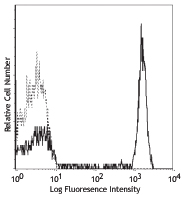
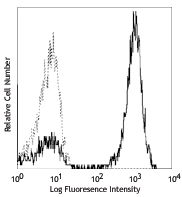
Compare Data Across All Formats
This data display is provided for general comparisons between formats.
Your actual data may vary due to variations in samples, target cells, instruments and their settings, staining conditions, and other factors.
If you need assistance with selecting the best format contact our expert technical support team.
-
APC anti-human CD8a
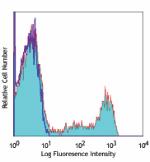
Human peripheral blood lymphocytes stained with RPA-T8 APC -
APC/Cyanine7 anti-human CD8a

Human peripheral blood lymphocytes were stained with CD3 FIT... -
Biotin anti-human CD8a
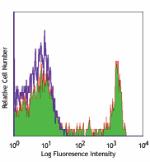
Human peripheral blood lymphocytes stained with biotinylated... -
FITC anti-human CD8a
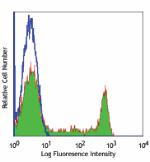
Human peripheral blood lymphocytes stained with RPA-T8 FITC -
PE anti-human CD8a

Human peripheral blood lymphocytes stained with RPA-T8 PE 
Human peripheral blood was stained with CD8a (clone RPA-T8) ... -
PE/Cyanine5 anti-human CD8a

-
PE/Cyanine7 anti-human CD8a
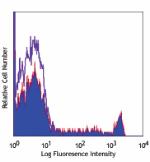
Human peripheral blood lymphocytes stained with RPA-T8 PE/Cy... -
Purified anti-human CD8a

Human peripheral blood lymphocytes stained with purified RPA... -
Alexa Fluor® 488 anti-human CD8a
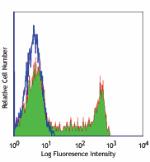
Human peripheral blood lymphocytes stained with RPA-T8 Alexa... -
Alexa Fluor® 647 anti-human CD8a

Human peripheral blood lymphocytes stained with RPA-T8 Alexa... -
Pacific Blue™ anti-human CD8a
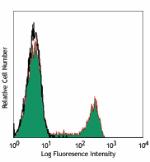
Human peripheral blood lymphocytes stained with RPA-T8 Pacif... -
Alexa Fluor® 700 anti-human CD8a
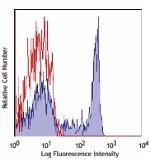
Human peripheral blood lymphocytes stained with RPA-T8 Alexa... -
PerCP anti-human CD8a
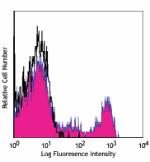
Human peripheral blood lymphocytes stained with RPA-T8 PerCP -
PerCP/Cyanine5.5 anti-human CD8a

Human peripheral blood lymphocytes were stained with CD3 APC... -
Brilliant Violet 421™ anti-human CD8a
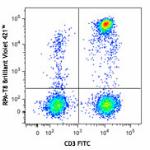

Human peripheral blood mononuclear cells were fixed with 2% ... 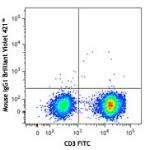
Human peripheral blood lymphocytes were stained with CD3 FIT... -
Brilliant Violet 570™ anti-human CD8a
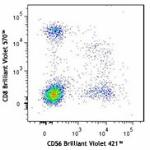

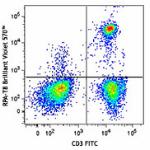
Human peripheral blood lymphocytes were stained with CD3 and... -
Brilliant Violet 605™ anti-human CD8a
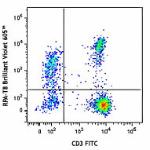
Human peripheral blood lymphocytes were stained with CD3 FIT... -
Brilliant Violet 650™ anti-human CD8a

Human peripheral blood lymphocytes were stained with CD3 FIT... -
Brilliant Violet 711™ anti-human CD8a

Human peripheral blood lymphocytes were stained with CD3 FIT... -
Brilliant Violet 785™ anti-human CD8a
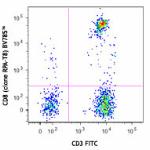
Human peripheral blood lymphocytes were stained with CD3 FIT... -
Brilliant Violet 510™ anti-human CD8a
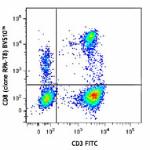
Human peripheral blood lymphocytes were stained with CD3 FIT... -
Purified anti-human CD8a (Maxpar® Ready)
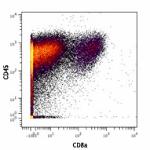
Human PBMCs stained with 154Sm-anti-CD45 (HI30) and 146Nd-an... -
Alexa Fluor® 594 anti-human CD8a
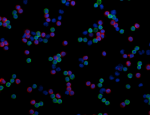
Human peripheral mononuclear cells were fixed with 2% parafo... 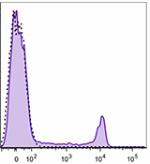
Human peripheral blood lymphocytes were stained with CD8 (cl... -
PE/Dazzle™ 594 anti-human CD8a
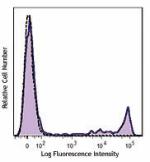
Human peripheral blood lymphocytes were stained with CD8 (cl... -
APC/Fire™ 750 anti-human CD8a

Human peripheral blood lymphocytes were stained with CD3 FIT... 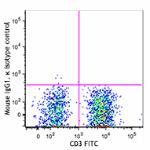
-
TotalSeq™-A0080 anti-human CD8a
-
TotalSeq™-B0080 anti-human CD8a
-
TotalSeq™-C0080 anti-human CD8a
-
Ultra-LEAF™ Purified anti-human CD8a
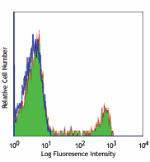
Human peripheral blood lymphocytes stained with LEAF™ purifi... -
Spark Violet™ 423 anti-human CD8a Antibody

Human peripheral blood lymphocytes were stained with anti-hu... -
Spark Red™ 718 anti-human CD8a

Human peripheral blood lymphocytes were stained with anti-hu... -
Spark PLUS UV395™ anti-human CD8a

Human peripheral blood lymphocytes were stained with anti-hu...













Follow Us